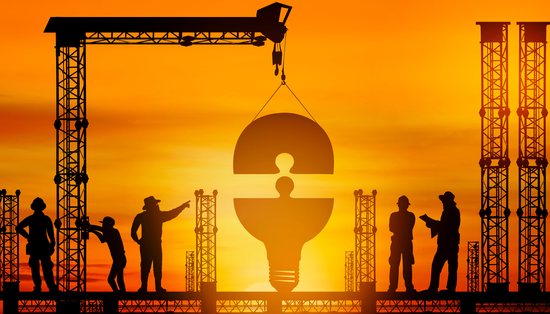
Navigating Post-COVID Construction Supply Chains
In the second installment of our series on navigating post-COVID construction, we take a closer look at the most notable changes to the supply chain. As decision-makers and owners, you’ll need to stay vigilant and resourceful, collaborating with a data-driven industry expert like WCCI to minimize supply chain disruptions and keep construction projects running according to plan.
While the construction supply chain is conventionally a secondary business operation, the newfound pressure on suppliers and timeline bottlenecks caused by the pandemic have demanded a re-evaluation of priorities. Decision-makers and owners need to make the adjustments on a granular level to stay competitive in a rapidly shifting economy.
Understanding Pandemic Supply Disruptions
The pandemic resulted in a series of industry and governmental actions that led to supply chain disruptions and delays with lingering effects. Essentially, COVID-19 revealed the vulnerabilities in many supply chain relationships in response to global crises.
1. The Fallout of Lockdown Policies
Countries affected by the pandemic have typically responded with a series of stringent lockdown policies such as containment measures and trade restrictions that limited the export of raw material supplies. Initial lockdowns caused as much as $30.1 trillion in global losses within 6 months. These earlier episodes led to a series of delayed and backlogged construction projects that are resuming with the recovering economy. However, the influx of resumed construction projects coupled with newly acquired assignments has led to unprecedented demand for raw materials, leading to price spikes.
Construction companies need to seek supply alternatives in response to timeline delays and shortages. With the post-pandemic economy still in a state of uncertainty, lockdown policies may recur, requiring construction companies to stay vigilant with proactive supply chain policies.
2. Material Shortages
Essential construction materials such as lumber and steel are currently facing shortages throughout the nation and beyond, due to the pandemic. Lumber prices surged in May at $1,686 per thousand board feet, a 406% increase from the previous year. While the prices have since reduced by over 65%, experts don’t predict a return to pre-pandemic levels until 2022. Additionally, a number of wholesale suppliers that purchased lumber at steep prices earlier in the year may sell backlog stock at elevated prices to reduce their losses.
The lumber shortages may have been a culmination of recent Canadian tariffs and rising demand for remodeling work as homeowners spend more time on their properties (i.e., hybrid offices and remote work). Additionally, the increased unemployment rate during the pandemic resulted in fewer drivers transporting lumber to mills and suppliers. Lumber prices may pick up in the next few months as the economy stabilizes.
Similarly, the price of steel tripled in May due to the imbalance of output and demand. Some manufacturers have placed orders for supplies scheduled for the last months of the year, which might ease some of the existing demand. While buyers have sought imported steel in large volumes due to limited domestic supply, these come with additional concerns such as high shipping fees and low container availability. Experts expect a turning point for steel prices in the first half of 2022 and recommend steel buyers to include escalator clauses in their contracts as a buffer against potential inflation.
3. Increased Labor Cost
The health concerns of the pandemic have led governments and industries to re-evaluate the safety/working conditions and the welfare of supply chain laborers, resulting in higher wages. These labor regulations may lead to inevitable increases in logistic costs for construction companies worldwide.
4. Price Fluctuations
Volatile demand is an expected industry response to a post-pandemic economy as the market recovers from the crisis. The situation forces more suppliers to prize long-term factors (i.e., supply chain assurance) over short-term gains (i.e., standardized profit-driven pricing). Additionally, the increasing trend of domestic production may lead to significant changes in trade risks and logistic fees.
5. Digital Sourcing and Supply Management
The rise of remote solutions will likely result in the continuous mass replacement of physical paperwork (i.e., inventory and invoicing). While traditional construction-supplier arrangements are primarily paper-based, the pandemic has led to increased digital documentation and processes implementation.
These digital documents will integrate with technologies such as AI and automation, resulting in more innovative collaborations that seamlessly identify and recruit alternative suppliers when the need arises. A digital transformation of supply chains might lead to large-scale vendor changes and cost adjustments.
Measures and Follow-ups
Construction companies should apply contingency crisis plans that support projects when critical supplies run low. These may include resilience strategies such as shoring up inventory during more stable market conditions and reducing the overdependence on a single source of supply. Some of these measures may remain in effect long after the pandemic, forming a part of the new status quo.
1. Move Away from Single-source Systems
Single-source supply chains are becoming less practical in the post-pandemic economy. For example, once a primary source of construction supplies (e.g., ceramic floor tiles and vinyl) known for its affordable rates, China has witnessed a recent rise in labor costs fueled by pandemic-related complications.
As such, there’s been a steady incline in the need for regional distribution centers, where construction companies can maintain an uninterrupted material supply for their project needs.
The shift away from single-source systems opens doors to alternate building materials, fluctuating costs and logistic reroutes that will require careful pricing adjustments. Eventually, more regional hubs will replace global providers, leading to flexible and adaptable supplies.
2. Leverage Emerging Technology and Processes
Enhanced risk evaluation will become a goal for many construction companies, making progress by implementing emerging technologies such as machine learning and AI. These solutions can offer deeper insight into risk and opportunities among supply chains by assessing patterns.
Decision-makers may also leverage these systems to reroute supply management with improved efficiency.
3. Choose Proactive over Reactive Practices
Supply chain operations and management will become a priority rather than simply a “backend” process in the construction field. More decision-makers will aim to understand their suppliers better to predict potential bottlenecks to facilitate more efficient response rates.
Rather than reacting to an unexpected supply chain scenario, construction companies will configure resilient systems with proactive policies that apply across diverse conditions. These dynamic frameworks will reduce the shock factor in future crises and keep projects progressing with minimal delay.
Some proactive measures may include purchasing ahead of a project, such as procuring raw materials in short supply within a region and pre-approving raw material substitutions in the event of disrupted primary suppliers.
WCCI – Construction Consulting for Navigating the Disruption
WCCI is a trusted construction consulting expert that provides decades of experience in construction solutions and cost estimates. We specialize in handling complex construction projects where every price deviation might result in disparate outcomes.
A comprehensive review of complexities in a post-COVID supply chain requires the practical knowledge of industry experts. Ideally, you should work with specialists who have navigated diverse economic situations and provided realistic insight and estimates in past projects.
By partnering with WCCI, decision-makers and owners can benefit from exclusive on-the-ground knowledge accrued by a specialized team in making improved data-driven decisions in the post-COVID supply chain. We can help reduce the guesswork to provide optimal data-based solutions and cost management guidance in times of uncertainty.
In the next installment of our series, we will take a deep dive into the impact of increased expenses and how construction companies can prepare for the shifting paradigm. In the meantime, you may reach out to a WCCI consultant to streamline your project estimates with clarity through an unparalleled depth of expertise.
Image Credits: Freepik @Creative Commons



